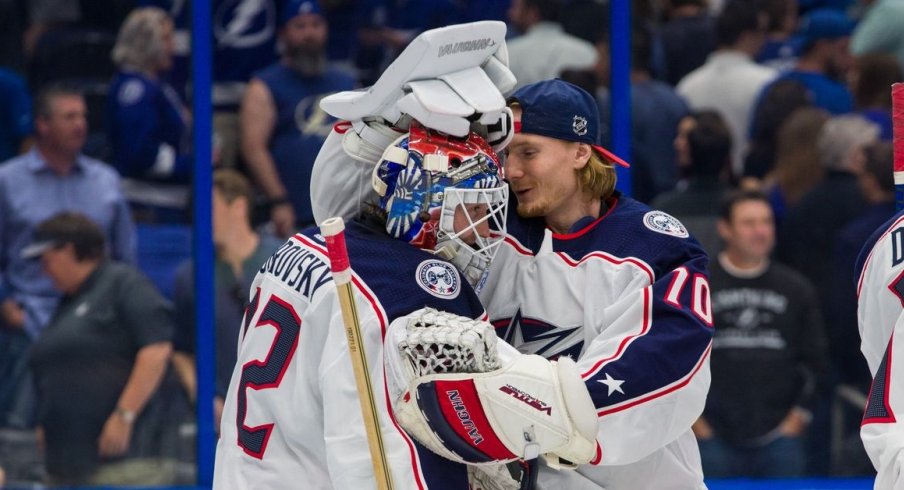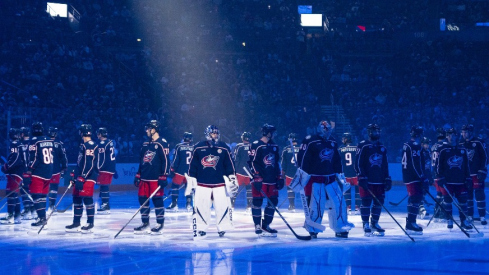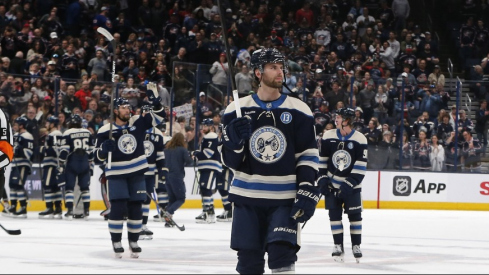Welcome to our final segment of our State of the Union miniseries, in which we dive deep into the Columbus Blue Jackets' organizational structure in terms of both the present and the future of the franchise.
Lastly, we examine the state of the Blue Jackets' goaltenders.
Management Hit A Home Run
If the Blue Jackets' deepest position is on the blue line, they may be most well-positioned in the current and near-future in the crease.
The organization has used the pause as an opportunity to extend contracts to both of their goaltenders, Joonas Korpisalo and Elvis Merzlikins, who were both pending RFAs. Born just 15 days apart and taken in the 3rd round of separate NHL Draft's, the two have taken dramatically different routes to get to where they are today. Korpisalo, who has waited patiently behind Sergei Bobrovsky since 2015-16, signed a two-year deal worth $5.6M ($2.8M AAV). On the other hand is Merzlikins, who bided his time in Switzerland before timing his jump to the NHL. His abysmal start to his NHL career is in stark contrast with a marvelous two-month stretch that he parlayed into a two-year contract worth $8M ($4M AAV).
As an aside, stick taps are in order for management, who brilliantly set the price for Korpisalo before negotiating with Merzlikins. Had it been the other way around, Korpisalo's camp would have been none-too-pleased that the Blue Jackets were offering a contract worth 70% of what Merzlikins signed while their client paid his dues behind Bobrovsky. Further stick taps for signing two young, legitimate NHL starting goalies to a combined $6.8M annual cap hit while Bobrovsky's contract ($10M through 2025-26) will hamstring Florida in more ways than one.
The Ceiling Is High, The Future Bright
Going into the season, it would have been difficult to believe that both of the following two statements are true:
- Korpisalo was named an NHL All-Star in his first season in the post-Bobrovsky era.
- Merzlikins is tied for second in the NHL in shutouts.
Alas, it's true, and the Blue Jackets were repaid masterfully in their (perceived) gamble to head into the 2019-20 season with no veteran goaltender in the organization acting as an insurance policy. Instead, Korpisalo's untimely injury proved to be a huge win for the organization, who was (like the rest of the NHL) able to see Merzlikins in extended action.
Both goalies are 26-years old, not young but certainly not old for goalies, who tend to develop later than players. Looking back at the most recent 15 years, only two goalies under 25 won a Vezina Trophy (Bobrovsky - 24, Andrei Vasilevskiy - 24), whereas the average age was 29.8 (per hockey-reference.com). That's good news for the Blue Jackets, who should benefit from years of either (or both?) of their prime years.
To Trade Or Not To Trade
Merzlikins got a higher paycheck moving forward simply due to his superior statistics compared by Korpisalo. Most notable is his Goals Saved Above Average (GSAA) metric, where Merzlikins finished 9th in the NHL (despite playing fewer games than all but one goalie ahead of him). Korpisalo finished 31st.
| Name | GP | W | L | OT | SV% | GAA | GSAA |
|---|---|---|---|---|---|---|---|
| Elvis Merzlikins | 33 | 13 | 9 | 8 | .923 | 2.35 | 12.1 |
| Joonas Korpisalo | 37 | 19 | 12 | 5 | .911 | 2.60 | 1.14 |
In both deals, the Blue Jackets bought one year of UFA years from their goalies, which gives them some flexibility moving forward. In signing them to two-year contracts, the club has hedged. Management knows that it's improbable they'll be able to keep both on the team once they each hit free-agency. Odds are therefore high that the Blue Jackets will move forward with one - but not both - of these two players long-term. Signing them for inexpensive contracts with short term could make that decision come sooner rather than later.
While splitting time and encouraging internal competition would be far from the worst thing in the world, I believe that the team would benefit from acquiring a scoring piece more than having a quality netminder on the bench. Those don't grow on trees, and teams rightfully require something in return. Is a relatively-young, starting goalie with two years of cost control (inexpensive, too) worth something? If the organization waits until the 2021 off-season, another team would be less inclined to trade for either goalie, who would at that point be 12 months away from UFA. Trading a piece sooner rather than later makes sense.
On the other hand, as Merzlikins will be exempt from the 2021 Seattle expansion draft, the Blue Jackets don't need to rush into a trade as a means to protect against losing a goalie for nothing. That logic could lead to the idea of holding onto both. Said GM Jarmo Kekalainen:
"We have two really good goaltenders under contract. The tandem worked well this year. It was a big part of our success. We feel it's going to be a big part of our success going into the future as well."
Pipeline
The Blue Jackets are fortunate to have strong organizational depth in goal. After graduating Merzlkins from 'prospect' to 'player', the franchise has three 23-year old and younger goalies in the pipeline, all of whom could see themselves in the NHL in their future.
Matiss Kivlenkieks is a familiar name to many. Due to injuries sustained this season by Korpisalo/Merzlikins, the Latvian played in six NHL games, going 1-1-2 with a .898 Sv%. He was marginally better in the AHL, going 9-8-3 with a .904 Sv%. He doesn't have the same pedigree as the current starters, but he's also ahead of schedule. He's a pending RFA, and could be squeezed out an organizational spot going forward, though, again, that could change with a trade to one of the goaltenders in Columbus.
Veini Vehvilainen started strong but cooled off in his first year in North America. In 33 games with Cleveland, he posted a 10-18-4 record with a .901 Sv%. At just 6'1 (I know, I know), his ceiling isn't perceived to be high, but he'll have at least one more AHL season before the book is closed on him. He has his supporters, like The Athletic's Scott Wheeler, who ranked the 23-year old #3 in the organization's prospect pool behind only Liam Foudy and Kirill Marchenko. He had this to say:
"Vehvilainen isn’t a flashy goalie, but he’s efficient; and if he can see the first shot, you can count on him to save it. Both Elvis Merzlikins and Joonas Korpisalo are pending RFAs, but even if they’re both back with the Blue Jackets, I’d expect Vehvilainen to challenge them for starts in 2020-21."
Coming in at #7 on that same ranking is Daniil Tarasov, who, at 6'5, is Vehvilainen's foil. The recently-turned 21-year old is projected to have the highest ceiling of any goalie perhaps in the organization. After dominating Russia's junior circuits, he was loaned for 2019-20 to Assat of Finland's top league, Liiga, where he went 11-17-9 with a .890 Sv% over 41 games. Per The Athletic's Aaron Portzline, Tarasov is "expected to play for AHL Cleveland beginning in 2020-21".
Daniil Tarasov makes quite the save with his glove here. #Liiga #CBJ pic.twitter.com/NAdJ2e3H4r
— Jokke Nevalainen (@JokkeNevalainen) October 3, 2019
Does the organization have room for all three prospects in Cleveland next year? Consider me skeptical, which lends more credence to the idea that an impending trade could be on the horizon.
Conclusion
An old adage in football is 'if you have two quarterbacks, you don't have one'. I don't believe the metaphor is appropriate in hockey, particularly as teams smarten up to the idea of two goalies splitting time more equitably. The Blue Jackets are one of the fortunate few in the NHL who have two young, quality goaltenders signed to team-friendly extensions. In an attempt to fortify other aspects of their organization, the club could look to use this advantage as a trade piece while each goalie is a prized commodity.


